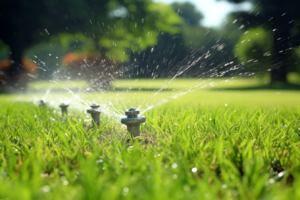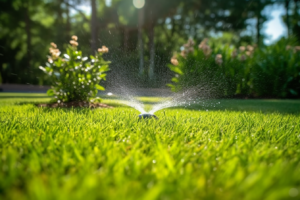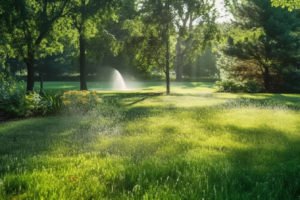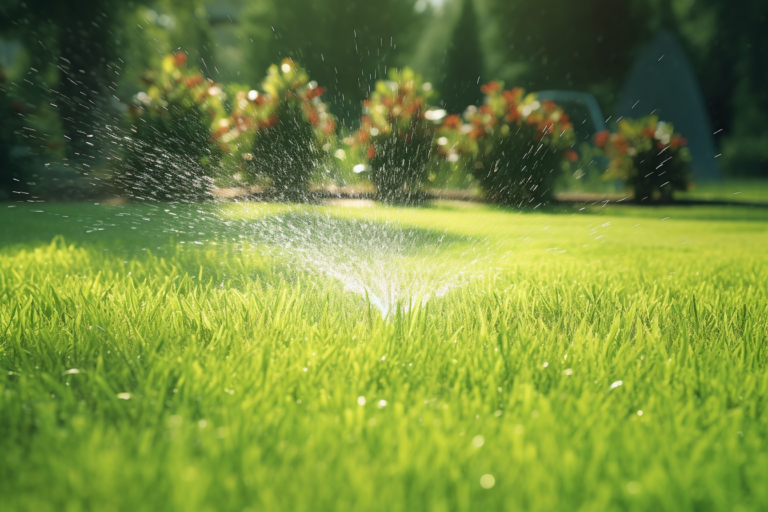Keeping a perfect lawn during summer might be challenging, especially due to high temperatures and lack of rainfall. Water is crucial in keeping grass healthy and preventing it from dried out, but how often should we water grass during summer? The frequency of watering, timing, and amount of water depends on multiple factors, including soil type, grass species, weather, and amount of foot traffic.
It’s recommended to water the lawn deeply and infrequently during summer, ideally once or twice a week. Giving it enough water to penetrate deep into the soil will help to develop a deep root system that can reach water stored into the ground. Shallow watering can cause the root system of the grass to grow closer to the surface and weaken the grass, making it more susceptible to drought conditions. Also, the time of day when watering is essential, watering in the morning or early afternoon can avoid evaporation, and minimize the risk of developing fungal diseases.
Best Time of Day to Water Your Grass
Choosing the right time of day to water your grass can have a significant impact on its health and overall growth. Watering at the wrong time of day can lead to wasted water, increased evaporation, and even damage to your lawn. In this section, I’ll explain the best time of day to water your grass and why it matters.
Early Morning
The best time of day to water your grass is in the early morning, before temperatures start to rise. Watering in the early morning allows the grass to absorb the moisture it needs before it gets too hot, meaning less water is wasted through evaporation. Additionally, the morning sun helps to dry any excess water on the grass blades, reducing the risk of disease or fungus.
Late Evening
If for some reason you can’t water in the morning, then late evening is the next best option. Watering after sunset can help to reduce evaporation, and the lower temperatures can also help to prevent the growth of certain types of fungus.
Midday
Watering between 11am and 3pm is the worst time to water your grass. The high temperatures and strong sun can lead to significant water loss due to evaporation, meaning your grass may not receive the water it needs to stay healthy. Additionally, watering during this time can increase the risk of fungal diseases due to the extended moisture on the grass blades.
In conclusion, watering your grass at the right time of day is essential for maintaining healthy, vibrant grass. The best time to water is in the early morning, with late evening being the next preferred option. Avoid watering during midday when temperatures are highest and water loss is greatest. By following these tips, you’ll be able to maintain a beautiful lawn while conserving water and promoting overall lawn health.
Factors That Determine How Often to Water Your Grass
There are several factors you should consider when determining how often to water your grass during the summer months:
Grass Type
Different grass types have different watering needs. For example, cool-season grasses such as fescue, ryegrass, and Kentucky bluegrass require more frequent watering than warm-season grasses like Bermuda and Zoysia. Additionally, the soil type in which your grass is growing can also impact watering frequency.
Climate
The climate in your region plays a significant role in determining how often you should water your grass. Areas with high temperatures, low precipitation, and high winds will require more frequent watering than cooler regions with more rain and less wind.
Soil Condition
The condition of your soil will also impact how often you need to water. Soil that is compacted or has a lot of clay will not absorb water as readily, and may require more frequent watering. Conversely, soil that is sandy may require fewer waterings since it drains more quickly.
Plant Maturity
Newly planted grass will require more frequent watering until it establishes deeper roots. Once established, mature grass will require less frequent watering.
Watering Method
The method you use to water your grass can also impact watering frequency. If you use an irrigation system, you may be able to water less frequently than if you use a hose and sprinkler. Additionally, the time of day you water can impact watering needs, as watering during the hottest part of the day can result in more evaporation.
It is important to keep these factors in mind when determining how often to water your grass during the summer months. By adjusting your watering schedule based on these factors, you can ensure that your grass remains healthy and vibrant throughout the season.
Signs Your Grass Needs Watering
As a homeowner with a lawn, it’s important to ensure your grass is getting enough water to thrive. But how do you know when it’s time to water your lawn? Here are some signs to look out for:
- Footprint Test: One easy way to determine if your lawn needs watering is by performing the footprint test. Step on your grass; if it springs back up, your lawn is getting enough water. If the grass stays compressed, it’s time to water.
- Color Change: Check for signs of color change in your grass. If your grass is looking dull and takes on a grayish tint, it’s likely experiencing drought stress.
- Leaf Folding: Another red flag to watch for is the folding of leaves. When grass is under stress, the blades will begin to fold to prevent moisture loss.
- Thatch Buildup: Thatch is a layer of organic material that builds up between the soil and the grass blades. A thatch buildup can create a barrier that prevents water from reaching the roots.
- Soil Moisture: The most effective way to know if your lawn needs watering is by checking the soil moisture. Use a screwdriver or gardening tool to poke into the soil. If it’s hard to push in, your lawn needs water.
It’s important to note that different types of grass require different watering schedules. For example, warm-season grasses need less water than cool-season grasses. It’s also best to water your lawn early in the morning to avoid evaporation. By paying attention to these signs, you can keep your lawn healthy and lush all summer long.
Recommended Frequency for Watering Grass in Summer
As we head into the hot summer months, it’s important to make sure our lawns stay healthy and hydrated. When it comes to watering grass in the summer, there are a few things to keep in mind. In this section, I’ll go over the recommended frequency for watering grass in the summer and some factors that can affect that frequency.
Factors that Affect Watering Frequency
Before diving into recommended watering frequencies, it’s important to consider a few factors that can impact how often you need to water your grass in the summer:
- Type of grass: Different types of grass have different water requirements, so it’s important to know what kind of grass you have before deciding on a watering schedule.
- Soil type: Soil with a lot of clay holds water differently than sandy soil, so you may need to adjust your watering frequency based on the soil type.
- Temperature and humidity: Hot and dry weather can quickly deplete soil moisture, while cooler or more humid weather may mean you can water less frequently.
- Rainfall: If your area has a rainy summer, you may need to water less frequently, while a dry summer may require more watering.
Recommended Watering Frequency
In general, most lawns need about 1 inch of water per week to stay healthy. However, this can vary depending on the factors mentioned above. Here are some recommended watering frequencies based on different factors:
- Newly seeded lawns: Newly seeded lawns need to be watered more frequently to keep the soil consistently moist. Water every day or every other day for the first few weeks, then gradually reduce the frequency.
- Sandy soil: Sandy soil doesn’t hold water well, so you may need to water more frequently, perhaps 2-3 times per week.
- Clay soil: Clay soil retains moisture better, so you may only need to water once a week.
- High temperatures: If temperatures are consistently above 90 degrees Fahrenheit, you may need to water every other day to prevent your lawn from drying out.
- Rainy weather: If you’ve had a good amount of rainfall, you may only need to water your lawn once a week or even less.
Remember, these are just guidelines and you should always adjust based on your lawn’s specific needs. As always, it’s important to water deeply and infrequently rather than shallowly and often. Watering deeply encourages strong root growth and helps your lawn withstand drought conditions.
Got it, thank you for the clarification. Here’s the “Tips for Properly Watering Your Grass” section:
Tips for Properly Watering Your Grass
- Water in the morning: The best time to water your grass in the summer is in the morning between 6 am and 10 am. This is because the cooler morning temperatures and the morning dew help the grass absorb water more efficiently. Avoid watering at night as this can lead to fungus growth.
- Water deeply and infrequently: Instead of watering your grass every day, water it deeply and infrequently. This encourages the roots to grow deeper, making your grass more drought-resistant. Aim to water your lawn to a depth of 6-8 inches.
- Adjust the frequency of watering according to weather conditions: In the summer, when temperatures are high and it’s dry, you may need to water your lawn more frequently. However, if it’s been raining frequently, you may not need to water your lawn at all.
- Use a water gauge: A water gauge can help you determine how much water your lawn needs. You can either buy a soil moisture gauge that will tell you how much water is in the soil, or you can use a rain gauge to measure how much water your lawn is receiving.
- Consider using a sprinkler: If you have a large lawn, using a sprinkler can be a convenient way to water your grass evenly. Make sure to adjust your sprinkler to avoid watering sidewalks, driveways, and other hard surfaces.
By following these tips for properly watering your grass, you can maintain a healthy and lush lawn throughout the summer without wasting water or damaging your grass.
Importance of Consistent Watering for Your Grass
Proper watering is essential for maintaining a healthy lawn. In the summer months, when the temperatures are high, your grass may require more water than usual. Consistent watering ensures that the soil stays moist and your grass gets the nutrients it needs to thrive.
Here are a few reasons why consistent watering is important for your grass:
- Prevents Drought Stress: Drought stress occurs when your grass doesn’t receive enough water. This can cause brown spots on your lawn and weaken the root system. Consistent watering can prevent drought stress and help your grass stay green and healthy.
- Promotes Root Growth: Consistent watering encourages deep root growth. When the soil is moist, your grass can grow deeper roots, which helps it access nutrients and water more easily.
- Improves Disease Resistance: Water-stressed lawns are more susceptible to disease. Consistent watering can improve the overall health of your lawn and make it more resistant to disease.
- Maximizes Fertilizer Efficiency: Fertilizer is essential for providing your grass with the nutrients it needs to grow. However, fertilizer is only effective when your grass receives enough water. Consistent watering helps maximize the efficiency of fertilizer, ensuring that your lawn receives the full benefit.
In general, experts recommend watering your grass deeply 1-2 times per week, rather than frequent light waterings. This allows water to reach the roots better and promotes deep root growth. However, the exact amount of water your grass needs depends on factors like soil type, grass type, and the climate in your area.
Remember, overwatering can be just as harmful as underwatering. So, it’s important to find the balance and water your lawn consistently to maintain optimal health.
What to Do If You Overwater or Underwater Your Grass
Even with the best of intentions, it’s still possible to end up overwatering or underwatering your grass. Here’s what you can do to correct the situation:
Overwatered grass
If you’ve overwatered your grass, the first step is to turn off the sprinkler system or irrigation system and let the grass dry out for a few days. Continuing to water the area will only make the problem worse. During this time, avoid mowing your lawn so that the grass can grow higher and avoid any further stress.
If the overwatering has caused the soil to become compacted, you may need to aerate your lawn to allow water and nutrients to better reach the roots. You can also add some compost or organic matter to improve soil quality.
Underwatered grass
Underwatered grass can start to turn brown and wither away. The first step is to start watering your lawn consistently again. You may need to water it for longer periods of time to allow the water to penetrate deeper into the soil.
It’s also important to monitor your lawn closely and adjust your watering schedule as needed. You may need to increase the frequency of watering during particularly hot and dry periods, or if you have sandy soil that drains water quickly.
If your lawn has already started to turn brown or go dormant due to underwatering, you can try to revive it by watering it deeply and applying a slow-release nitrogen fertilizer. Be patient, as it may take several weeks for your grass to fully recover.
Alternative Methods to Keep Your Grass Moist
While watering your lawn is the most common way to keep it moist during the summer, there are alternative methods you can try to reduce water usage and promote healthy grass growth.
Use Mulch
Mulching around your grass can help retain moisture in the soil and reduce water evaporation. Use organic materials like shredded leaves or grass clippings around your grass to help it stay hydrated longer.
Adjust Your Mower Height
Cutting your grass too short can lead to moisture loss. If you leave the grass taller, it will help shade the soil and retain moisture. Adjust your mower height to leave the grass at about 3 inches long.
Time Your Watering
Watering your grass during the early morning is the most effective time as it allows the water to be absorbed before the sun rises and evaporates it. Avoid watering during the afternoon as it can lead to water loss through evaporation.
Use Drip Irrigation
Consider using drip irrigation in place of traditional sprinkler systems. Drip irrigation allows you to target the roots of your grass, reducing water waste and evaporation.
Aerate Your Lawn
Compacted soil can prevent moisture from being absorbed by your grass roots. Aerating your lawn can create small holes in the soil to promote water penetration and increase absorption rates.
By utilizing these alternative methods, you can reduce water usage while promoting healthy grass growth. Try incorporating one or more of these methods into your lawn care routine to keep your grass hydrated and looking its best all summer long.
Common Mistakes to Avoid When Watering Your Grass
When it comes to watering your grass, overwatering and underwatering can ruin your lawn. Here are some common watering mistakes to avoid:
Overwatering
Overwatering your grass can lead to a variety of problems, including root rot, fungal growth, and the growth of weeds. Many people tend to water their lawns daily or for longer durations to compensate for the heat. This is not good for the grass. Overwatering makes it difficult for the roots to get oxygen, which can lead to root rot.
Underwatering
Underwatering your lawn can cause it to wilt and turn brown. It can also stunt root growth, making the grass more susceptible to disease and pests. Generally, a lawn requires about 1 inch of water per week, including rainfall. However, this amount can differ depending on various factors, such as grass type, climate, soil type, and sun exposure.
Watering at the Wrong Time
Watering at the wrong time of day can also affect your lawn’s health. Watering during the hottest parts of the day can lead to rapid evaporation, which means that less water will reach the roots. On the other hand, watering during the nighttime can lead to prolonged leaf wetness, which can cause fungal growth.

Not Adjusting for Rain
Watering your lawn after it has rained can lead to overwatering. Make sure to check the weather forecast and adjust your watering schedule accordingly. If it has rained recently, you may not need to water your lawn as much.
Watering Unevenly
Watering unevenly can result in patchy lawns. Make sure to use a sprinkler that covers your entire lawn and water for the same amount of time in each area. Additionally, you may need to adjust the sprinkler head to avoid watering sidewalks, driveways, or other areas that don’t need water.
By avoiding these common watering mistakes, you can help ensure a healthy and lush lawn throughout the summer.
Upon considering all factors, it’s clear that the key to maintaining healthy grass during the summer months is to water it properly. Remember to keep these key points in mind:
- Water deeply and infrequently, rather than frequently for short periods of time.
- Ensure that your watering routine is consistent—grass can suffer from both overwatering and underwatering.
- Consider investing in an irrigation system to make the process easier.
- Keep an eye out for signs of dehydration, including yellowing or wilting grass.
- Be sure to adjust your watering routine based on weather conditions, such as periods of heavy rain.
By following these guidelines and paying close attention to your lawn’s needs, you can ensure that your grass stays healthy, lush, and vibrant all summer long.
How Often to Water Grass In Texas Summer?
In Texas, summers can be hot and dry, so it’s essential to provide your lawn with the appropriate amount of water. The ideal watering frequency for grass in Texas during the summer months is typically 1 to 1.5 inches of water per week. This can be broken down into two or three watering sessions per week, ideally during the early morning hours to minimize evaporation.

Keep in mind that different grass types may have different watering requirements, and factors such as soil type, shade, and recent rainfall can also affect how often you should water your lawn. It’s essential to monitor your lawn’s health and adjust your watering schedule as needed to maintain a healthy, green lawn.
How Often to Water Fescue Grass In Summer?
During the summer months, fescue grass typically requires about 1 to 1.5 inches of water per week to maintain its health and appearance. You can break this down into two or three watering sessions per week, ideally during the early morning hours when temperatures are cooler and evaporation is minimized.
Keep in mind that factors such as local climate, soil type, and recent rainfall can influence your fescue lawn’s specific watering needs. Be sure to monitor your lawn’s health and adjust your watering schedule accordingly. In periods of extreme heat or drought, fescue grass may require additional water to prevent stress and maintain its health.
How Often to Water Grass In Arizona Summer?
During the hot and dry summer months in Arizona, lawns typically require more frequent watering to maintain their health and appearance. It’s generally recommended to provide your grass with 1 to 1.5 inches of water per week, divided into two or three watering sessions. Watering should ideally be done during the early morning hours or late evening to minimize evaporation and maximize water absorption.
However, factors such as grass type, soil type, and local climate can influence the specific watering needs of your lawn. Be sure to monitor your lawn’s health and adjust your watering schedule as needed. Additionally, consider employing water-saving techniques such as using a smart irrigation controller and implementing proper lawn care practices to maintain a healthy lawn while conserving water.
How Often to Water New Grass Seed in Summer?
Watering new grass seed in the summer requires more attention and care, as the higher temperatures and increased evaporation can make it more challenging for the seedlings to establish. To ensure proper germination and growth, follow these guidelines:

Water lightly but frequently: Keep the soil consistently moist by watering lightly 2-4 times a day, depending on the temperature and weather conditions. Avoid overwatering, as it can lead to seed runoff and fungal diseases.
Water during cooler times of day: To minimize evaporation and maximize water absorption, water early in the morning and late in the evening.
Gradually reduce watering frequency: As the seedlings grow and establish, you can start reducing the frequency of watering while maintaining the same total amount of water per week. For example, after two weeks, you might decrease to watering once a day, and then after three weeks, to every other day.
Monitor and adjust: Keep an eye on the weather and the health of your new grass. Adjust your watering schedule if necessary, particularly if there’s rain or if the temperature becomes extremely hot.
Remember that the specific watering needs of your new grass seed may vary depending on factors like grass type, soil type, and local climate. Always be attentive to your lawn’s needs and make adjustments as required.
FAQS
Can I water my lawn at night during the summer?
It is best to avoid watering your lawn at night, as this can lead to prolonged dampness and increased risk of fungal diseases. Instead, water your lawn early in the morning.
How can I tell if my lawn is getting enough water?
Signs that your lawn is receiving adequate water include a lush, green appearance, and a springy, resilient texture. Signs of water stress include wilting, visible footprints, and a bluish-gray color.
Can I rely on rainfall alone to water my lawn in the summer?
Depending on your local climate, rainfall alone may not be sufficient to meet your lawn's water needs during the summer months. Monitor rainfall using a rain gauge and supplement with manual watering as needed.
How long should I water my lawn to reach the recommended 1 to 1.5 inches per week?
The duration of watering will depend on the output of your sprinkler system. To measure output, place a series of small containers (such as tuna cans) throughout your lawn, and run your sprinklers for 15 minutes. Measure the water collected in the containers, and adjust your watering duration accordingly to reach the desired amount.
Is it better to use a sprinkler or a hose to water my lawn in the summer?
A sprinkler system or soaker hoses can provide more consistent and efficient watering than a handheld hose. They also allow for easy use of timers to ensure proper watering frequency and duration.


I always wondered how often I should water my grass in the summer. Thanks for the helpful tips! I’ll make sure to follow them to keep my lawn looking healthy and green.